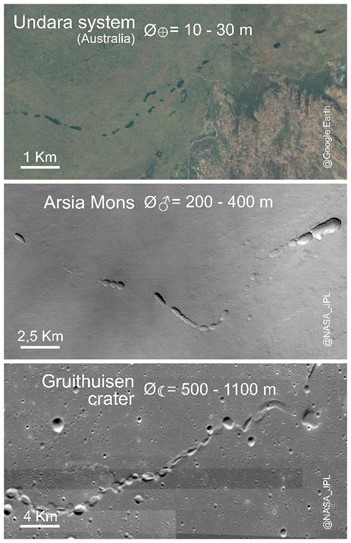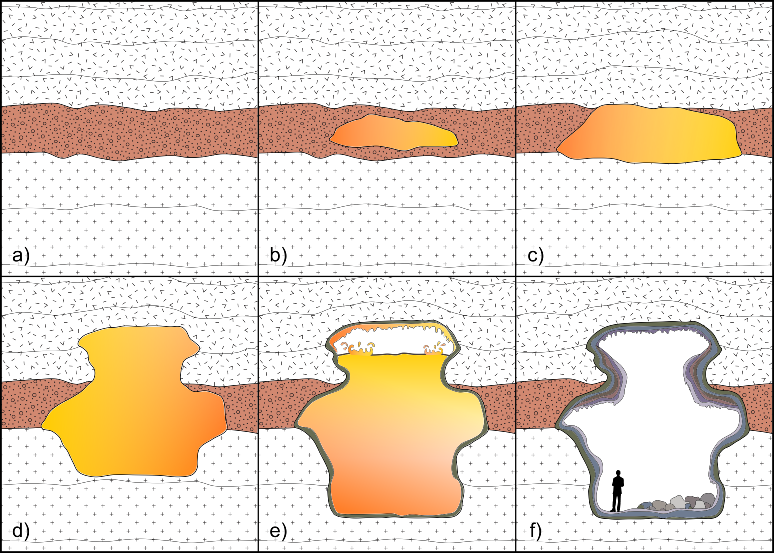Large size lava tubes as planetary analogues: the case of La Corona (Lanzarote, Canary Islands)
- 1Department of Geosciences - University of Padova, Padova, Italy (ilaria.tomasi.93@gmail.com)
- 2Department of Biological, Geological and Environmental Sciences (BiGeA), University of Bologna, Bologna, Italy
- 3INAF - Osservatorio Astronomico di Padova, Italy
- 4Virtual Geographic Agency (ViGeA), Reggio Emilia, Italy
- 5Instituto de Geociencias, IGEO (CSIC-UCM), Madrid, Spain;
- 6Geopark of Lanzarote, Cabildo Insular, Lanzarote, Spain
These structures are easily recognizable from the surface through the presence of skylights and roof collapses aligned in pit-chains, tracing the path of the underground conduit (Fig. 1). Analogous aligned collapses were seen on the surfaces of Mars and the Moon [2]. Thus, the great interest in studying large terrestrial lava tube systems is largely driven by their analogy with their extra-terrestrial equivalents.

Figure 1: Comparison of lava tubes from different rocky bodies of the Solar System. From the left: Earth (Undara system, Australia), Mars (Arsia Mons region) and the Moon (Gruithuisen crater).
The main difference between structures of different planetary bodies are due to intrinsic physical characters of the parental body and above all gravity. Indeed, a weaker gravity (as in the case of Mars and the Moon) results in higher effusion rates and, thus, larger lava flows and tubes (Fig. 1). This has led to pyroducts which are two or three orders of magnitude smaller in diameter on Earth (10 - 30 m) than on Mars (250 - 400 m) and the Moon (500 - 1100 m) [5]. Despite this different scaling, the largest lava tubes on Earth are considered to be very useful analogues to their extra-terrestrial counterparts.
A clear understanding of how large pyroducts form and evolve remains elusive, even on Earth. Within this context, our work aims to identify the processes that shaped the formation of terrestrial lava tubes. Among the most studied pyroducts, the La Corona system (Lanzarote, Canary Islands, Spain) stends out for its geological context within the Canary Island Seamount Province (CISP) on which long-term and spatially focused volcanic activity developed over a poorly mobile tectonic plate. During the last 30 Ma, the absolute motion of the African plate has been nearly stationary (less than 20 mm/yr) [3]. This environment identifies the Canaries as one of the best terrestrial analogues of the Martian one-shell plate volcanism [4], and the impressive dimensions of La Corona lava tube (~9.7 km of total cave development, and a width reaching up to ~28 m for some of its sections) make it one of the most suitable lava tube for interplanetary analogies [6].
In order to understand the origin, evolution and degradation of the La Corona pyroduct, we have carried out a study of the satellite images of the northern region of Lanzarote, followed by field exploration of inner portions of the La Corona lava tube and adjacent areas.
Combining terrestrial laser scanner (TLS) technology with field observations and geochemical analyses of the pre-existing lava enabled us to reconstruct the three-dimensional geometry of the lava tube system, the subsurface horizon through which it starts developing, and the volcanic series into which the pyroduct carved its path.
What makes this inflated lava tube so interesting is the presence, between the flows the tube has crossed, of a red pyroclastic layer, resulting from the initial Strombolian activity of La Corona vent [7]. This weak layer of pyroclastic material played a major role in the development of the lava tube (Fig. 2), facilitating the emplacement of the inflation process and the excavation that followed [6]. By analogy, similar geological settings could be favourable for the formation of lava tubes on rocky bodies like Mars and the Moon since the volcanic sequences on such bodies can be frequently interleaved by either weak pyroclastic and regolith layers.
Other influent parameters controlling erosion include slope variations of the paleo-surface (i.e., knickpoints), and the lava physical properties, both to be well investigated on terrestrial analogues to understand their role even on planetary contexts.

Figure 2: Thermo-mechanical erosional stages of the lava tube in cross-sections. a) The primary effusive phase has covered the pyroclastic deposit of the initial Strombolian event; b) the inception of the tube by inflation starts exploiting the pyroclastic layer; c-d-e) progressive erosion and enlargement of the tunnel; f) post-cooling phase. On the walls are visible different layers of linings and flow ledges. The floor is covered by blocks and debris, remnants of the breaking down of the ceiling and lining walls.
References
[1] Coan, T. (1844). Missionary Herald. [2] Haruyama, J. et al. (2012) Trans. JAPAN Soc. Aeronaut. Sp. Sci. Aerosp. Technol. JAPAN 10. [3] Gaina, C. et al. (2013). Tectonophysics, 604, 4-25. [4] Meyzen, C. M., et al. (2015) Geol. Soc. London, Spec. Publ. 401. [5] Sauro et al. (2020) Earth-Science Rev. [6] Tomasi, I. et al. (pending) JGR – Solid Earth. [6] Carracedo, J. C. et al. (2003) Estud. Geol. 59.
How to cite: Tomasi, I., Massironi, M., Meyzen, C. M., Sauro, F., Pozzobon, R., Penasa, L., Santagata, T., Martìnez-Frìas, J., and Mateo Mederos, E.: Large size lava tubes as planetary analogues: the case of La Corona (Lanzarote, Canary Islands), Europlanet Science Congress 2022, Granada, Spain, 18–23 Sep 2022, EPSC2022-1003, https://doi.org/10.5194/epsc2022-1003, 2022.

